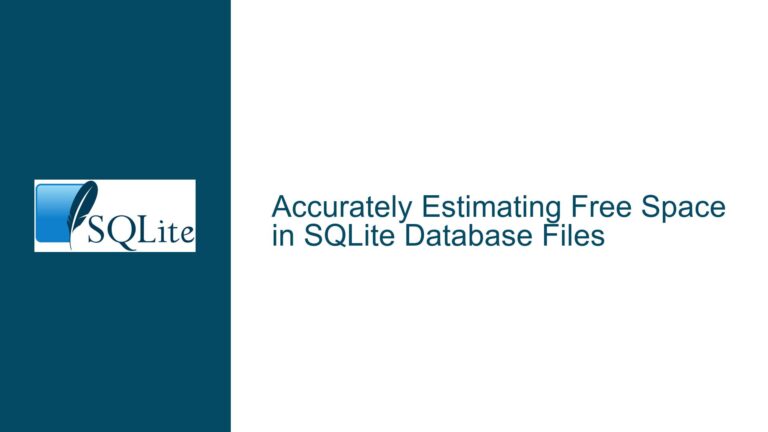Handling Ambiguous Column Names in SQLite Query Results
Understanding Column Name Ambiguity in SQLite Query Results
When working with SQLite, one common issue that arises during query execution is the ambiguity of column names in the result set, especially when joining multiple tables. This problem occurs because SQLite, by default, does not prepend table names to column names in the result set. For example, if you have two tables, Table1 and Table2, both containing a column named id, the result set will display id twice without any indication of which table each id belongs to. This can lead to confusion, particularly when processing the result set programmatically or when the query involves multiple tables with overlapping column names.
The issue becomes more pronounced when dealing with complex queries involving multiple joins, as the result set can quickly become cluttered with ambiguous column names. This not only makes it difficult to interpret the results but also increases the risk of errors when referencing columns in application code or further SQL operations. The problem is exacerbated when the schema evolves over time, and new columns are added to tables, potentially introducing new naming conflicts.
Exploring the Causes of Ambiguous Column Names in SQLite
The root cause of this issue lies in SQLite’s default behavior of not including table names in the column headers of the result set. This behavior is by design, as SQLite aims to provide a lightweight and fast database engine without the overhead of additional metadata in the result set. However, this design choice can lead to ambiguity when querying multiple tables with overlapping column names.
Another contributing factor is the common practice of using generic column names such as id, name, or value across multiple tables. While this practice simplifies schema design, it increases the likelihood of column name conflicts in query results. Additionally, SQLite does not enforce unique column names across different tables, allowing for the possibility of identical column names in multiple tables.
The issue is further compounded by the lack of a built-in mechanism in SQLite to automatically prepend table names to column names in the result set. While some other database systems provide options to include table names in the result set, SQLite does not offer a straightforward way to achieve this without manually aliasing each column in the query.
Resolving Ambiguous Column Names: Techniques and Best Practices
To address the issue of ambiguous column names in SQLite query results, several techniques and best practices can be employed. The most straightforward approach is to manually alias each column in the query to include the table name. This can be done using the AS keyword to explicitly specify the desired column names in the result set. For example:
SELECT
Table1.id AS Table1_id,
Table1.name AS Table1_name,
Table2.id AS Table2_id,
Table2.refTable1 AS Table2_refTable1,
Table2.name AS Table2_name
FROM
Table1
INNER JOIN
Table2
ON
Table1.id = Table2.refTable1;
This approach ensures that each column in the result set is uniquely identified by its table name, eliminating any ambiguity. However, it requires manually specifying each column, which can be cumbersome for queries involving many columns or tables.
Another approach is to adopt a naming convention that ensures unique column names across the entire database schema. This can be achieved by prefixing each column name with a shortened version of the table name. For example, instead of using id and name in both Table1 and Table2, you could use Table1_id, Table1_name, Table2_id, and Table2_name. This convention not only resolves the ambiguity in query results but also makes the schema more self-documenting.
However, this approach has its drawbacks. Renaming a table would require updating all associated column names to maintain consistency, which can be error-prone and time-consuming. Additionally, it can lead to verbose column names, which may be less readable and more cumbersome to work with in application code.
A more advanced technique involves using SQLite’s PRAGMA statements to control the display of column names in the result set. Specifically, the PRAGMA full_column_names and PRAGMA short_column_names settings can be used to influence how column names are displayed. However, these settings are not recommended for general use, as they can lead to inconsistent behavior and may not be supported in future versions of SQLite.
In practice, the best approach depends on the specific requirements and constraints of your project. For small projects or ad-hoc queries, manually aliasing columns may be sufficient. For larger projects or those with evolving schemas, adopting a consistent naming convention for column names can provide a more robust solution. Additionally, using tools or libraries that automatically handle column name resolution can help mitigate the issue without requiring manual intervention.
Ultimately, the key to resolving ambiguous column names in SQLite query results lies in careful schema design, consistent naming conventions, and thoughtful query construction. By understanding the underlying causes of the issue and applying the appropriate techniques, you can ensure that your SQLite queries produce clear and unambiguous results, making your database interactions more reliable and maintainable.






